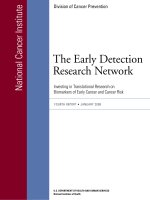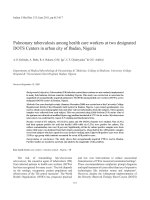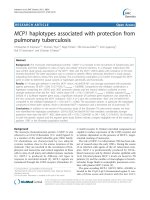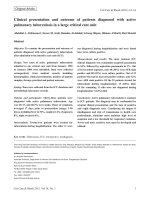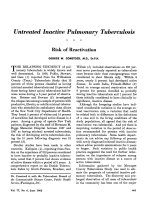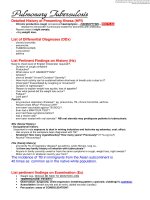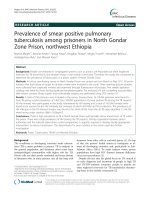Breath biomarkers of active pulmonary tuberculosis doc
Bạn đang xem bản rút gọn của tài liệu. Xem và tải ngay bản đầy đủ của tài liệu tại đây (245.94 KB, 7 trang )
DIAGNOSTICS
Breath biomarkers of active pulmonary tuberculosis
Michael Phillips
a
,
b
,
*
, Victoria Basa-Dalay
c
,
h
, Graham Bothamley
d
,
i
, Renee N. Cataneo
a
,
j
,
Phung Kim Lam
e
,
k
, Maria Piedad R. Natividad
f
,
l
, Peter Schmitt
g
,
m
, James Wai
a
,
j
a
Menssana Research Inc., 1 Horizon Road, Suite 1415, Fort Lee, NJ 07024-6510, United States
b
Department of Medicine, New York Medical College, Valhalla, NY, United States
c
Tuberculosis Research Unit, Angelo King Medical Research Center, De La Salle Health Sciences Institute, Cavite, Philippines
d
Department of Respiratory Medicine, Homerton University Hospital NHS Foundation Trust, London E9 6SR, England, UK
e
Division of Pulmonary and Critical Care Medicine, University of California San Diego, 200 West Arbor Drive, San Diego, CA 92103-8374, USA
f
Center for Respiratory Medicine, The University of Santo Tomas Hospital (USTH), Espan
˜a
Boulevard, Manila 1008, Philippines
g
Schmitt & Associates, 211 Warren St, Newark, NJ 07103, United States
article info
Article history:
Received 27 October 2009
Received in revised form
18 January 2010
Accepted 26 January 2010
Keywords:
Tuberculosis
Breath
Volatile
Biomarker
Diagnosis
summary
Background: Vola tile organic compounds (VOCs) in breath may contain biomarkers of active pulmonary
tuberculosis derived from the infectious organism (metabolites of Mycobacterium tuberculosis) and from
the infected host (products of oxidative stress).
Methods: We ana lyzed breath VOCs in 226 symptomatic high-risk patients in USA, Philippines, and UK,
using gas chromatography/mass spectroscopy. Diagnosis of disease was based on sputum culture, smear
microscopy, chest radiography and clinical suspicion of tuberculosis (CSTB). Chromatograms were
converted to a series of 8 s overlapping time slices. Biomarkers of active pulmonary tuberculosis were
identified with a Monte Carlo analysis of time-slice alveolar gradients (abundance in breath minus
abundance in room air).
Results: Breath VOCs contained apparent biomarkers of active pulmonary tuberculosis comprising
oxidative stress products (alkanes and alkane derivatives) and volatile metabolites of M. tuberculosis
(cyclohexane and benzene derivatives). Breath biomarkers identified active pulmonary tuberculosis with
C-statistic (area under curve of receiver operating characteristic) ¼ 0.85 (i.e. 85% overall accuracy,
sensitivity ¼ 84.0%, specificity ¼ 64.7%) when sputum culture, microscopy, and chest radiography were
either all positive or all negative. Employing a single criterion of disease, C-statistic ¼ 0.76 (smear
microscopy), 0.68 (sputum culture), 0.66 (chest radiography) and 0.65 (CSTB).
Conclusion: A breath test identified apparent biomarkers of active pulmonary tuberculosis with 85%
accuracy in symptomatic high-risk subjects.
Ó 2010 Elsevier Ltd. All rights reserved.
Active pulmonary tuberculosis (TB) is a leading cause of death
from infectious disease throughout the world. Two billion people –
one third of the world’s population – are infected with Mycobac-
terium tuberculosis and 1.6 million died from the disease in 2005.
1
Globally, the countries of sub-Saharan Africa suffer the highest
incidence of TB as a consequence of the HIV/AIDS epidemic.
2
In
these countries, the disproportionate amount of smear-negative
disease has greatly complicated TB case detection and disease
control.
3
There has also been a resurgence of TB in developed
countries. After approximately 30 years of decline, the number of
TB cases reported in the United States increased 20% during 1985–
1992, and this has been accompanied by the emerging threat of
multidrug-resistant TB.
1
Microscopy and culture are still the mainstay of laboratory
diagnosis of TB,
4
and there is an urgent need for better diagnostic
tools, especially in high-burden countries. An ideal diagnostic test
would be sensitive and specific for active pulmonary TB, as well as
rapid, cost-effective, non-invasive, and suitable for use in devel-
oping countries. A breath test might rationally fulfill these
requirements because Mycobacteria manufacture unique volatile
*
Corresponding author. Menssana Research Inc., 1 Horizon Road, Suite 1415, Fort
Lee, NJ 07024-6510, United States. Tel./fax: þ1 201 886 7004.
E-mail addresses: (M. Phillips), vict oriadalay@
yahoo.com (V. Basa-Dalay), (G. Bothamley), rca-
(R.N. Cataneo), (M.P.R. Lam), peach yna-
(M.P.R. N atividad), peter .schmitt@ schmittassociates.com (P. Schmitt),
(J. Wai).
h
Tel.: þ63 46 416 0226x238.
i
Tel.: þ44 (0) 20 8510 7814.
j
Tel.: þ1 973 643 5464.
k
Tel.: þ1 619 543 5550; fax: þ1 619 543 3276.
l
Tel.: þ63 (02) 731 3001.
m
Tel.: þ1 973 733 2225.
Contents lists available at ScienceDirect
Tuberculosis
journal homepage: />ARTICLE IN PRESS
1472-9792/$ – see front matter Ó 2010 Elsevier Ltd. All rights reserved.
doi:10.1016/j.tube.2010.01.003
Tuberculosis xxx (2010) 1–7
Please cite this article in press as: Phillips M, et al., Breath biomarkers of active pulmonary tuberculosis, Tuberculosis (2010), doi:10.1016/
j.tube.2010.01.003
organic compounds (VOCs) as metabolites with distinctive odors
when cultured in vitro.
5–7
The best-known application of breath
testing is detection of alcohol consumption, but newer and more
sensitive breath tests have detected products of normal physio-
logical processes such as oxidative stress,
8
and biomarkers of
diseases including asthma,
9
lung cancer,
10
heart transplant rejec-
tion,
11
and infection with Helicobacter pylori.
12
However, detection
of volatile disease biomarkers is technically difficult because most
breath VOCs are excreted in picomolar concentrations (parts per
trillion), and most analytical instruments in current use cannot
detect VOCs in such low concentrations. Members of our group
have approached this problem by developing a breath collection
apparatus (BCA) that collects and concentrates breath VOCs on to
sorbent traps for analysis by gas chromatography and mass spec-
troscopy (GC/MS).
13,14
In a previous study employing this test, we
observed apparent biomarker VOCs in the breath of patients with
active pulmonary TB, and a number of these VOCs were similar to
VOCs observed in vitro in cultures of M. tuberculosis.
15
We performed a multicenter international study of breath VOCs
in patients at high risk of active pulmonary TB in order to identify
breath biomarkers of disease, and to determine the diagnostic
accuracy of the test.
Materials and methods
Human subjects
Patients at high risk of active pulmonary TB
226 technically satisfactory breath samples and sputum cultures
were obtained from high-risk patients at four sites: the University
of California San Diego, California (38). The University of Santo
Tomas, Manila, Philippines (100), De La Salle University Hospital,
Cavite, Philippines (66), and The East London Tuberculosis Service,
London, England (22). Patients aged 13 yr or older were defined as
‘‘high-risk’’ and included in the study if they had one or more
symptoms or radiographic findings consistent with the diagnosis of
active TB, and/or an epidemiologic risk factor for TB (e.g. immi-
grants or refugees from high-burden countries). Patients were
excluded if they had more than one previous sputum smear that
was positive for acid-fast bacilli during the past six months, if they
were currently being treated for TB, if they had received more than
seven days of treatment for TB during the past six months, or if
there was evidence of extrathoracic TB.
Clinical evaluation
A medical history was obtained from all high-risk patients,
followed by a physical examination and a chest radiograph. Sputum
samples were collected on three different occasions employing
sputum induction or bronchoalveolar lavage where indicated.
Liquid cultures were performed (Bactec 460, Becton Dickinson,
Sparks, MD) as well as microscopic examinations for acid-fast
bacilli. Three smears and three cultures were performed for each
patient. A chest radiograph was classified as abnormal if any of the
following features were observed: cavity, infiltrate, fibrosis, bron-
chiectasis, pleural effusion, hilar or mediastinal adenopathy. The
physician’s clinical judgment of the final diagnosis was also deter-
mined, employing a standardized formal evaluation of clinical
suspicion of tuberculosis (CSTB) based upon the diagnostic criteria
listed above, as well as the medical history, patient demographics,
physical examination, and response to treatment.
33
IRB approval and informed consent
The research was approved by an Institutional Review Board at
all collaborating sites, and all subjects gave their signed informed
consent to participate. Assent from adolescent subjects and consent
from a parent or legal guardian was obtained for subjects 13–16 yr
in England or younger than 18 yr at sites in other countries.
Breath sample collection
The method has been described.
12,1 8
A portable breath collection
apparatus (BCA) was employed to capture the VOCs in 1.0 L breath
and 1.0 L room air on to separate sorbent traps. The geometry of the
breath reservoir of the BCA ensured that the sample comprised
>99% alveolar breath. Subjects wore a nose-clip and respired
normally for 2.0 min through a disposable and previously unused
valved mouthpiece with a bacterial filter to prevent Mycobacterial
contamination of the instrument. The mouthpiece and filter
presented low resistance to respiration, ensuring that samples
were collected without discomfort to patients.
Breath sample analysis
The method has been described.
8,13
VOCs captured in the
sorbent traps were analyzed in the laboratory by automated
thermal desorption, gas chromatography and mass spectroscopy
(ATD/GC/MS). In order to quantify peak areas and to control for drift
in instrument performance, an internal standard was run with
every chromatographic assay of breath and air (0.25 mL 2 ppm
1-bromo-4-fluorobenzene, Supelco, Bellefonte, PA).
Masking procedures
Neither the clinicians collecting breath samples nor the clinical
staff performing sputum cultures were aware of the results of the
breath test. Similarly, the laboratory staff performing the breath
assays had no access to any clinical information about the subjects.
Masking was not broken until data were analyzed.
Analysis of data and statistical methods
Diagnostic criteria
Patients were diagnosed with active pulmonary TB according to
a single criterion i.e. positive sputum culture, positive sputum
smear microscopy, or abnormal chest radiogram. A triple criterion
was also employed (i.e. positive or negative for all three tests).
Concordance between test results was evaluated with Kappa and
McNemar’s test.
16
Clinical judgment (CSTB) was separately
employed as a single criterion of active pulmonary TB.
Chromatographic data
Chromatograms were converted into a series of data points by
segmenting them into a series of 900 time slices, each with eight
sec duration and four sec overlap. The alveolar gradient of each
time slice was determined (i.e. abundance in alveolar breath minus
abundance in ambient room air).
13,17
In each time slice, alveolar
gradient ¼ V
b
/I
b
À V
a
/I
a
where V
b
denotes the integrated abundance
of analytes detected by mass spectroscopy in breath, and I
b
denotes
the area under the curve (AUC) of the chromatographic peak
associated with the internal standard. V
a
and I
a
denote corre-
sponding values derived from the associated sample of room air.
Identification of biomarker time slices
Alveolar gradients were compared in patients who were posi-
tive or negative for active pulmonary TB, and ranked as candidate
biomarkers according to the value of the C-statistic i.e. the AUC of
the receiver operating characteristic (ROC) curve.
18
We employed
Monte Carlo simulations to select the chromatographic time slices
that identified active pulmonary TB with better than random
accuracy, in order to minimize the risk of including random iden-
tifiers of disease.
19,20
The average random behavior of chromato-
graphic time slices was determined by randomly assigning subjects
to the ‘‘active pulmonary TB positive’’ or ‘‘active pulmonary TB
M. Phillips et al. / Tuberculosis xxx (2010) 1–72
ARTICLE IN PRESS
Please cite this article in press as: Phillips M, et al., Breath biomarkers of active pulmonary tuberculosis, Tuberculosis (2010), doi:10.1016/
j.tube.2010.01.003
negative’’ groups, and performing 40 estimates of the C-statistic
value of each time slice. For any given value of the C-statistic, it was
then possible to compare the mean number of time slices exceeding
that value by correct assignment or by random assignment.
Conservative predictive algorithms were constructed with multi-
variate weighted digital analysis (WDA) models
10
employing the
time slices identified by multiple Monte Carlo simulations.
Tentative identification of biomarker VOCs
The chemical identity of the major VOC in each time slice was
tentatively identified by the similarity of its mass spectrum to the
mass spectrum of a known compound in a computer-based library
(Turbo Mass Software, PerkinElmer Life And Analytical Sciences,
Waltham, MA 02451).
Results
Human subjects
Table 1 displays demographics, prevalence of symptoms, results
of chest radiography, sputum culture, and sputum microscopy, and
subjects assessed as positive or negative for active pulmonary TB.
No subject reported any adverse effects associated with breath
sample donation.
Concordance between tests for active pulmonary TB
Table 3 displays concordance between results of smear
microscopy, sputum culture and chest radiography. Kappa values
and results of McNemar’s test
16
indicate low agreement between
these three diagnostic methods, except for sputum culture versus
smear microscopy for which agreement was moderate.
Construction of predictive algorithms
10 time slices with C-statistic >¼0.73 were identified of which
only 5 were statistically significant. All combinations of 5/10 time
slices were analyzed separately and the combination that yielded
the lowest C-statistic was selected. This was the conservative lower
limit of the analysis, and the true value may have been higher.
Identification of breath biomarkers of active pulmonary TB
Figure 1 displays the outcomes of single and multiple Monte
Carlo simulations in subjects who were positive or negative for
active pulmonary TB, employing triple criterion of disease. The
mean outcome of 40 Monte Carlo simulations demonstrated 10
time slices with an AUC of 0.73 or higher. The excess of correct over
random time slices indicated that 5/10 of them comprised non-
random biomarkers of active pulmonary TB. Table 2 displays
tentative structural identification of the most abundant VOC in
each of these time slices.
Sensitivity and specificity of breath biomarkers of active pulmonary
TB
Figure 1 displays ROC curves for active pulmonary TB employing
the single and the triple criterion of disease as well as CSTB.
Multivariate WDA models employed the most conservative of all
possible models (i.e. the model with the lowest C-statistic) derived
from time slices identified by multiple Monte Carlo simulations.
Employing triple criterion of disease, breath biomarkers identified
active pulmonary tuberculosis with C-statistic ¼ 0.85 (i.e. 85%
overall accuracy, sensitivity ¼ 84.0%, specificity ¼ 64.7%). Employ-
ing single criterion of disease, C-statistic ¼ 0.76 (smear micros-
copy), 0.68 (sputum culture), and 0.66 (chest radiography) and 0.65
(CSTB).
Discussion
Analysis of breath VOCs demonstrated apparent volatile
biomarkers of active pulmonary TB, in an international multicenter
study of high-risk patients. The VOC biomarkers may have been
derived from the infective organism, the host, or from both.
These findings were consistent with the results of an earlier
pilot study because the breath VOC biomarkers were similar to
those previously observed in human breath, and also to the volatile
metabolites of M. tuberculosis observed in vitro.
15
The breath VOC
biomarkers observed in both studies included derivatives of
cyclohexane, benzene, decane and heptane. The structure of these
VOCs was similar but not identical in the two reports – for example
1,3,5-trimethylbenzene was identified as a breath biomarker in this
study and 1,2,3,4-tetramethylbenzene was observed in the pilot
study. There are only minor differences between the mass spectra
of these two compounds, and it may be difficult to differentiate
them with current GC/MS instruments. The breath VOC biomarkers
were also similar to volatile metabolites of M. tuberculosis observed
in vitro. In the pilot study,
15
reference samples of M. tuberculosis
were cultured in sealed containers and VOC metabolites were
sampled from the gaseous phase above the liquid incubation
medium. Common VOCs observed in vitro and in breath included
Table 1
Human subjects.
No. patients enrolled 226
Female/male 101/125
Age
mean yr (SD) 43.8 (16.8)
Range (yr) 15–78
History of tobacco or cannabis use (yes/no/unknown) 107/118/1
Symptoms
cough (yes/no/unknown) 178/47/1
unintentional weight loss(yes/no/unknown) 146/84/6
fever (yes/no/unknown) 84/138/4
night sweats(yes/no/unknown) 68/156/2
Investigations
sputum culture (positive/negative) 65/161
sputum microscopy (positive/negative/unknown) 30/188/8
chest radiogram (abnormal/normal/unknown) 187/24/15
Table 2
Breath VOC biomarkers of active pulmonary TB.
Oxetane, 3-(1-methylethyl)-
Dodecane, 4-methyl-
Cyclohexane, hexyl-
Bis-(3,5,5-trimethylhexyl) phthalate
Benzene, 1,3,5-trimethyl-
Decane, 3,7-dimethyl-
Tridecane
1-Nonene, 4,6,8-trimethyl-
Heptane, 5-ethyl-2-methyl-
1-Hexene, 4-methyl-
Ten chromatographic time slices were identified as biomarkers of active pulmonary
TB in patients who were positive for all three criteria of disease (sputum culture,
smear microscopy, and chest radiography). The most abundant chemical species in
each time slice was identified by mass spectroscopy. These VOCs may have been
derived from either or both the host and the organism. Alkanes (e.g. tridecane) and
methylated alkane derivatives (e.g. dodecane, 4-methyl-) are products of oxidative
stress. Other VOCs on this list (including benzene, 1,3,5-trimethyl-, cyclohexane,
hexyl-, and 1-hexene, 4-methyl-) are structurally similar to VOCs previously
observed as metabolites of M. tuberculosis in vitro.
M. Phillips et al. / Tuberculosis xxx (2010) 1–7 3
ARTICLE IN PRESS
Please cite this article in press as: Phillips M, et al., Breath biomarkers of active pulmonary tuberculosis, Tuberculosis (2010), doi:10.1016/
j.tube.2010.01.003
derivatives of cyclohexane, benzene, heptane and hexane. Again,
the chemical structures were similar but not identical. In addition,
alkanes and alkane derivatives have been previously observed in
human breath as VOC products of oxidative stress.
8,23
These find-
ings are consistent with previous reports that M. tuberculosis
manufactures volatile metabolites,
5–7
and that patients with active
pulmonary TB exhibit increased oxidative stress.
24,25
The accuracy of a new diagnostic test is usually determined by
comparing its performance to an accepted gold standard of
disease. This study was limited by comparing the performance of
the breath test to gold standards whose accuracy is known to be
less than perfect e.g. a study of patients with a confirmed clinical
diagnosis of active pulmonary TB demonstrated sensitivity of 70%
for sputum culture and 61.5% for sputum smear microscopy,
though both were 100% specific.
38
Chest radiographic criteria are
nonspecific for active pulmonary TB and, except for cavitation, are
common sequelae of nontuberculous causes. Kappa values and
results of McNemar’s test
16
indicated low agreement between the
three diagnostic criteria, except for moderate agreement between
sputum culture and smear microscopy, consistent with previous
reports of discrepant findings between these tests.
26,27
These
limitations may account, in part, for the results of this study,
because no new diagnostic test could possibly exhibit better
sensitivity and specificity for active pulmonary TB than the gold
standard to which it is compared. In this study, when sputum
culture was employed as the gold standard of disease, the ROC
curve in Figure 1 indicated that the breath test was approxi-
mately 70% sensitive and 70% specific. When a combined triple
criterion of disease was employed, the breath test was approxi-
mately 70% sensitive and 92% specific, which approaches the
reported accuracy of sputum culture.
38
Consequently, where the
breath test appeared to misclassify patients with false-positive or
false-negative findings, these errors may have arisen, at least in
part, from deficiencies in the gold standards to which it was
compared.
The accuracy of the breath test was assessed with the C-statistic,
or AUC of the ROC curve, which is typically used to assess how well
a test or model separates individuals into two classes, such as
diseased and non-diseased.
18,28
The value of the C-statistic may
vary between 0.5 (discriminatory value no better than chance) and
1.0 (a perfect test, with no false-positive or false-negative results).
The value of the breath test C-statistic varied according to the
diagnostic criterion employed: positive sputum smear microscopy
(0.76), positive sputum culture (0.68), abnormal chest radiography
(0.66) or CSTB (0.65). However, when a more rigorous diagnostic
criterion was employed, in which sputum culture, smear and chest
radiography were all positive or all negative, the breath test
C-statistic value was increased to 0.85 i.e. the breath test identified
patients with active pulmonary TB with an overall accuracy of 85%,
with sensitivity ¼ 84% and specificity ¼ 64.7% (i.e. true positive
rate ¼ 84%, false-positive rate ¼ 35.3%). In clinical practice, similar
results might be reasonably anticipated in primary screening of
other high-risk populations. However, clinicians have the option of
selecting a different test cutoff value that would yield a higher true
positive rate at the expense of a higher false-positive rate. The
expected positive and negative predictive values of the breath test
were not determined in this study, since they will vary with the
prevalence of active pulmonary TB in the populations where the
test is employed in the future.
In 1971, Pauling reported the first evidence of a highly
complex set of low-molecular weight VOCs in human breath. He
cryogenically concentrated samples of normal breath, analyzed
the samples employing the then-new technology of gas chro-
matography, and demonstrated the presence of large numbers of
VOCs in low concentrations.
29
Subsequent studies employing
mass spectroscopy with gas chromatography have tentatively
identified the chemical structure of more than 3000 different
VOCs in human breath.
30
However, mass spectroscopy may
identify a breath VOC incorrectly if the mass spectrum is
contaminated by noise in the chromatogram. This can result from
several causes including the simultaneous coelution of two
different VOCs. For this reason, analysis of the VOCs in a gas
chromatogram by retention times alone may provide an intrin-
sically more robust technique that is less susceptible to error. 30
years ago, Stern et al employed time-slice chromatography to
differentiate between different strains of Enterobacteriaceae and
Yersinia enterocolitica.
31,32
The principle is straightforward: the
chromatogram is partitioned into a series of time slices, each of
equal duration, and the integrated abundance of chromatographic
peaks in each time slice is determined. The chromatogram is
thereby converted to a time series of data points. Chromatograms
derived from two populations may then be compared employing
multivariate analysis of data, in order to identify the specific time
slices that distinguish between the two groups. The advantage of
this approach is that it minimizes the risk of experimental error
in primary identification of breath biomarkers, while it also
permits tentative identification of their chemical structure by
mass spectroscopy.
The clinical value of diagnostic breath testing lies in its ability to
sample blood VOCs in a non-invasive manner, after they have
passively diffused from blood into breath across the alveolar
Table 3
Concordance between diagnostic tests for active pulmonary TB.
Sputum culture versus chest radiography
sputum culture Kappa McNemar’s
test
positive negative
chest radiography positive 59 (26.1%) 128 (56.6%) 0.05 <0.0001
negative 4 (1.8%) 20 (8.8%)
Sputum culture versus smear microscopy
sputum culture
positive negative
smear microscopy positive 26 (11.5%) 4 (1.8%) 0.47 <0.0001
negative 36 (15.0%) 152 (67.3%)
Chest radiography versus smear microscopy
smear microscopy
positive negative
chest radiography positive 29 (12.8%) 154 (68.1%) 0.04 <0.0001
negative 0 (0.0%) 21 (9.3%)
This table displays the concordance between results of sputum culture, sputum
smear microscopy for acid-fast bacilli, and chest radiography in the patient pop-
ulation. Twice-measured data may be evaluated with two types of measures: Kappa
indicates whether agreement was beyond chance, and McNemar’s test assesses the
symmetry of the misses about the diagonal.
For sputum culture versus chest radiography, Kappa ¼ 0.05 indicated little to no
agreement beyond chance, and a discrepancy was significantly more likely to be an
abnormal chest radiogram with a negative sputum culture.
For sputum culture versus smear microscopy, Kappa ¼ 0.47 indicated moderate
agreement beyond chance, and a discrepancy was significantly more likely to be
a negative smear microscopy with a positive sputum culture.
For chest radiography versus smear microscopy, Kappa ¼ 0.04 indicated little to no
agreement beyond chance, and a discrepancy was significantly more likely to be an
abnormal chest radiogram with a negative sputum smear microscopy.
Overall, Kappa values indicated little to no agreement beyond chance between
different criteria for diagnosis of active pulmonary TB, with the exception of
moderate agreement between sputum culture and smear microscopy. The statisti-
cally significant outcomes of McNemar’s tests indicated that the disagreement was
represented by strong patterns of unequal discordance. Note that the total of the
four boxes in each category does not add up the total number of patients studied
(226) because results were unknown for 8 sputum microscopies and 15 chest
radiographs.
M. Phillips et al. / Tuberculosis xxx (2010) 1–74
ARTICLE IN PRESS
Please cite this article in press as: Phillips M, et al., Breath biomarkers of active pulmonary tuberculosis, Tuberculosis (2010), doi:10.1016/
j.tube.2010.01.003
membrane. The most familiar application is breath alcohol testing,
which has been widely employed for many years for the estimation
of blood alcohol levels. However, progress in medical applications
of breath testing has been comparatively slow until recent years
because of the technical challenges. Unlike breath ethanol which is
excreted in parts per thousand or higher, most breath VOC
biomarkers of disease are excreted in very low concentrations:
parts per billion or parts per trillion i.e. six to nine orders of
magnitude more dilute than ethanol. Consequently, microanalysis
of breath VOCs requires specialized instrumentation for the
collection and analysis of samples. Recent progress in this
technology has enabled breath testing to move into the mainstream
of medical diagnostic applications, The United States Food & Drug
Administration has approved clinical use of the Heartsbreath test
0.5
0.55
0.6
0.65
0.7
0.75
0.8
0.90.80.70.60.5
C-statistic - random diagnosis
C-statistic - correct diagnosis
Single
Monte Carlo
simulation
0
5
10
15
20
25
30
35
40
45
50
0.5 0.6 0.7 0.8
C-statistic cutoff value
Excess no. time slices
Random
Correct
Mean of
multiple
Monte Carlo
simulations
0
0.2
0.4
0.6
0.8
1
0 0.2 0.4 0.6 0.8 1
sputum culture 0.76
sputum smear 0.68
chest x-ray 0.66
final diagnosis 0.65
AUC
0
0.1
0.2
0.3
0.4
0.5
0.6
0.7
0.8
0.9
1
00.51
1-s
p
ecificit
y
(
FPR
)
Sensitivity (TPR)
sensitivity =84.0%
specificity =64.7%
Positive for sputum smear
and sputum culture
and chest x-ray
AUC = 0.85
Figure 1. Breath biomarkers of active pulmonary TB. Single Monte Carlo simulation (top left): Patients were classified as positive for active pulmonary TB if all of three criteria of
disease were positive (sputum culture, sputum smear, and abnormal chest radiogram), and negative for disease if all three criteria were negative. Each chromatographic time slice
was evaluated as a candidate biomarker of active pulmonary TB by determination of its C-statistic value, derived from differences between alveolar gradients in subjects who were
positive or negative for disease. This figure displays the C-statistic of each chromatographic time slice employing either randomized or correct assignment of diagnosis of active
pulmonary TB on the x- and y-axes respectively. In this particular simulation, correct diagnosis was associated with 10 time slices with C-statistic >¼0.73, compared to 5 with
randomized diagnosis i.e. when the diagnosis was randomly assigned. There was an excess of 5 time slices over the random outcome. Multiple Monte Carlo simulations (top right):
This figure displays the mean outcome of 40 Monte Carlo simulations performed in the same fashion as the single simulation shown in the upper panel. Curves display the mean
number of chromatographic time slices exceeding a given AUC cutoff with random or correct assignment to the diagnostic group (positive or negative for active pulmonary TB). If
the breath contains a signal of active pulmonary TB, the correct assignment curve should be significantly higher than the randomized curve, depending upon the number of true
biomarkers present in the data. At C-statistic cutoff value ¼ 0.73, a mean excess of 5 (i.e. 10 À 5) time slices was observed with correct assignment of diagnostic group. This excess of
correct over random time slices indicated that 5/10 VOCs comprised non-random biomarkers of active pulmonary TB. Accuracy of the breath test using a single criterion of disease
(bottom left): The ROC curves displays the accuracy of the breath test for active pulmonary TB when a single criterion of disease was either positive or negative (sputum culture,
sputum smear, abnormal chest radiogram, or CSTB respectively). Accuracy of the breath test using three criteria of disease (bottom right): The ROC curve displays the accuracy of the
breath test for active pulmonary TB when all three criteria of disease were either positive or negative (sputum culture, sputum smear, and abnormal chest radiogram). The
predictive model was a multivariate WDA algorithm employing 5/10 VOCs in the breath chromatogram that were identified by multiple Monte Carlo simulations. The ROC curve
employed the most conservative model possible i.e. the multivariate model with the lowest C-statistic derived from all possible combinations of 5 out of 10 of them. The VOCs in
these time slices are shown in Table 2. The lowest C-statistic was 0.85, and the sensitivity and specificity of the breath test is shown at the shoulder of the ROC curve where their
sum was maximal.
M. Phillips et al. / Tuberculosis xxx (2010) 1–7 5
ARTICLE IN PRESS
Please cite this article in press as: Phillips M, et al., Breath biomarkers of active pulmonary tuberculosis, Tuberculosis (2010), doi:10.1016/
j.tube.2010.01.003
for heart transplant rejection,
11,37
and clinical studies have reported
breath VOC biomarkers in a number of diseases including asthma,
9
lung cancer,
10
and infection with H. pylori.
12
Breath testing is rapid, non-invasive, and completely safe. It
could potentially be employed as a primary screening tool in
populations at increased risk of TB. Since the combination of
sensitivity and specificity of a test is dependent upon the choice of
the diagnostic cutpoint value in the ROC curve, it may be tailored
to the circumstances of clinical practice.
21,22
For example, in
a setting with limited resources, the cutpoint might be adjusted
for higher specificity and lower sensitivity. This would identify
patients at high risk of active pulmonary TB without over-
burdening the health care system with an excessive number of
false-positive results. The breath test might also be employed with
two cutpoints (e.g. at 90% sensitivity and 90% specificity respec-
tively) so that patients could be triaged into groups at high,
intermediate, or low risk of disease.
The cost of breath testing for active pulmonary TB in clini cal
practice may not be inferred from th is study because we
employed a laboratory-based ATD/GC/MS instrument for VOC
biomarker di sc ove ry. MS is expensive because it requires
sophisticated pumping and seali ng technology to generate and
maintain a high vacuum, and an instrument modified for breath
VOC assays may cost approximately $200,000. Currently, only
MS tech nology can provide definitive structural identification of
breath VOCs, but that refinement will not be necessary in
clinical practice because a point-of- care i nstrument empl oying
ATD/GC with a less expensive detector may be optimized to
detect the VOC biomarkers identified in this study. Members of
our group have developed point-of-care instruments that
collect, concentrate, and analyze breath VOCs for approximately
one tenth the c ost of laboratory ATD/GC/MS. They are currently
initiating a follow-up study of breath testing for active pulmo-
nary TB employing a point-of-care instrument with an ATD/GC/
surface acoustic wave detector that cost s app roximately
$20,000. This point-of-care breath test might eventually provide
a highly cost-effective primary screening tool for the detection
of active pu lmonary TB, w ith a low per-test cost in a busy
clinical setting.
For this reason, an important objective of future research will be
to adapt the breath test to a less expensive analytical platform that
delivers results within minutes at the point-of-care. This objective
has yet to be fulfilled, though its feasibility is supported by recent
advances in breath testing technology.
34–36
We conclude that a breath test detected apparent volatile
biomarkers of active pulmonary TB, and that this test has potential
applications in clinical practice.
Acknowledgements
This research was supported by SBIR award R44 AI52504-03
from NIH/NIAID. Michael Phillips is President and CEO of
Menssana Research, Inc.; he had access to and takes responsi-
bility for the integr ity of the data and the accuracy of the data
ana lysis. Other coauthors have no financial interest in the subject
matter or any conflict of interest. Michael Phillips d esigned and
supervised the study and drafted the manuscript. Victoria
Basa-Dalay, Graham Bothamley, Phung Kim Lam, and Maria Pie-
dad R. Natividad recruited patients and collate d data at the
clinical research sites, Renee N Cataneo analyzed the samples in
the laboratory, and Peter Schmitt, and James Wai analyzed the
data statistically. James J . Grady, DrPH (Office of Biostatistics, The
University of Texas Medical Branch at Galveston) provided
independent s tatistical review of the report. All authors made
significant contrib uti ons to the study and approve the
manuscript.
Funding: None.
Competing interests: None declared.
Ethical approval: Not required.
References
1. Anon. World TB Day – March 24, 2008. MMWR 2008;57(11):281.
2. Zar HJ. Global paediatric pulmonology: out of Africa. Paediatr Respir Rev
2006;7(Suppl. 1):S226–S228.
3. Perkins MD, Cunningham J. Facing the crisis: improving the diagnosis of
tuberculosis in the HIV era. J Infect Dis 2007;196(Suppl. 1):S15–S27.
4. Cho SN, Brennan PJ. Tuberculosis: diagnostics. Tuberculosis (Edinb)
2007;87(Suppl. 1):S14–S17.
5. Pavlou AK, Turner AP. Sniffing out the truth: clinical diagnosis using the elec-
tronic nose. Clin Chem Lab Med 2000;38(2):99–112.
6. Zhang Y, Zhuang Y, Liu Z, Ruan J. Identification of twenty-eight species
mycobacteria with their cellular fatty acids by capillary gas chromatography.
Wei Sheng Wu Xue Bao 1991;31(3):187–97.
7. Syhre M, Chambers ST. The scent of Mycobacterium tuberculosis. Tuberculosis
(Edinb) 2008;88(4):317–23.
8. Phillips M, Cataneo RN, Greenberg J, Gunawardena R, Naidu A, Rahbari-
Oskoui F. Effect of age on the breath methylated alkane contour, a display of
apparent new markers of oxidative stress. J Lab Clin Med 2000;136(3):243–9.
9. Kharitonov SA, Barnes PJ. Biomarkers of some pulmonary diseases in exhaled
breath. Biomarkers 2002;7(1):1–32.
10. Phillips M, Altorki N, Austin JH, et al. Detection of lung cancer using weighted
digital analysis of breath biomarkers. Clin Chim Acta; Int J Clin Chem
2008;393(2):76–84.
11. Phillips M, Boehmer J, Cataneo R, et al. Heart allograft rejection: detection with
breath alkanes in low levels (the HARDBALL study). J Heart Lung Transpl
2004;23:701–8.
12. Braden B, Lembcke B, Kuker W, Caspary WF. 13C-breath tests: current state of
the art and future directions. Dig Liver Dis 2007;39:795–805.
13. Phillips M. Method for the collection and assay of volatile organic compounds
in breath. Anal Biochem 1997;247(2):272–8.
14. Phillips M, Altorki N, Austin JH, et al. Prediction of lung cancer using volatile
biomarkers in breath. Cancer Biomark 2007;3(2):95–109.
15. Phillips M, Cataneo RN, Condos R, et al. Volatile biomarkers of pulmonary
tuberculosis in the breath. Tuberculosis (Edinb) 2007;87(1):44–52.
16. Suzuki S. Conditional relative odds ratio and comparison of accuracy of
diagnostic tests based on 2 Â 2 tables. J Epidemiol/Jpn Epidemiol Assoc
2006;16(4):145–53.
17. Phillips M, Greenberg J, Awad J. Metabolic and environmental origins of volatile
organic compounds in breath. J Clin Pathol 1994;
47(1
1):1052–3.
18. Cook NR. Statistical evaluation of prognostic versus diagnostic models: beyond
the ROC curve. Clin Chem 2008;54(1):17–23.
19. Zou YY, Yang J, Zhu J. A robust statistical procedure to discover expression
biomarkers using microarray genomic expression data. J Zhejiang Univ Sci
2006;7(8):603–7.
20. Ma S, Song X, Huang J. Regularized binormal ROC method in disease classifi-
cation using microarray data. BMC Bioinform 2006;7:253.
21. Phillips M, Altorki N, Austin J, et al. Detection of lung cancer using weighted
digital analysis of breath biomarkers. Clin Chim Acta 2008;393:76–84.
22. Michiels S, Koscielny S, Hill C. Prediction of cancer outcome with microarrays:
a multiple random validation strategy. Lancet 2005;365(9458):488–92.
23. Kneepkens CM, Lepage G, Roy CC. The potential of the hydrocarbon breath test
as a measure of lipid peroxidation. Free Radic Biol Med 1994;17(2):127–60.
24. Lamsal M, Gautam N, Bhatta N, Toora BD, Bhattacharya SK, Baral N. Evaluation
of lipid peroxidation product, nitrite and antioxidant levels in newly diagnosed
and two months follow-up patients with pulmonary tuberculosis. Southeast
Asian J Trop Med Public Health 2007;38(4):695–703.
25. Kwiatkowska S, Piasecka G, Zieba M, Piotrowski W, Nowak D. Increased serum
concentrations of conjugated diens and malondialdehyde in patients with
pulmonary tuberculosis. Respir Med 1999; 93(4):272–6.
26. Gatner EM, Burkhardt KR. Correlation of the results of X-ray and sputum
culture in tuberculosis prevalence surveys. Tubercle 1980;61(1):27–31.
27. Wilcke JT, Kok-Jensen A. Diagnostic strategy for pulmonary tuberculosis in
a low-incidence country: results of chest X-ray and sputum cultured for
Mycobacterium tuberculosis. Respir Med 1997;91:281–5.
28. Lasko TA, Bhagwat JG, Zou KH, Ohno-Machado L. The use of receiver operating
characteristic curves in biomedical informatics. J Biomed Inform 2005;38:
404–15.
29. Pauling L, Robinson AB, Teranishi R, Cary P. Quantitative analysis of urine vapor
and breath by gas–liquid partition chromatography. Proc Natl Acad Sci U S A
1971;68:2374–6.
30. Phillips M, Herrera J, Krishnan S, Zain M, Greenberg J, Cataneo RN. Variation in
volatile organic compounds in the breath of normal humans. J Chromatogr B
Biomed Sci Appl 1999;729(1–2):75–88.
M. Phillips et al. / Tuberculosis xxx (2010) 1–76
ARTICLE IN PRESS
Please cite this article in press as: Phillips M, et al., Breath biomarkers of active pulmonary tuberculosis, Tuberculosis (2010), doi:10.1016/
j.tube.2010.01.003
31. Stern NJ, Kotula AW, Pierson MD. Differentiation of selected Enter-
obacteriaceae by pyrolysis–gas–liquid chromatography. Appl Environ Microbiol
1979;38(6):1098–102.
32. Stern NJ, Kotula AW, Pierson MD. Virulence prediction of Yersinia enterocolitica
by pyrolysis gas–liquid chromatography. Appl Environ Microbiol
1980;40(3):646–51.
33. Catanzaro A, Lam P, Bothamley G, et al. Using clinical suspicion of tuberculosis
(CSTB) to evaluate a rapid lateral flow (RLF) serologic immunoassay. Am J Respir
Crit Care Med 2007;175:A576.
34. Laakso O, Haapala M, Jaakkola P, et al. The use of low-resolution FT-IR spec-
trometry for the analysis of alcohols in breath. J Anal Toxicol 2000;24(4):250–6.
35. Ueno M, Shinada K, Yanagisawa T, et al. Clinical oral malodor measurement
with a portable sulfide monitor. Oral Dis 2008;14(3):264–9.
36. Hockstein NG, Thaler ER, Lin Y, Lee DD, Hanson CW. Correlation of pneumonia
score with electronic nose signature: a prospective study. Ann Otol Rhinol
Laryngol 2005;114(7):504–8.
37. FDA website for Heartsbreath: />andMedicalProcedures/DeviceApprovalsandClearances/Recently-Approved
Devices/ucm081213.htm.
38. Prasad R, Lath SK, Mukerji PK, Agrawal SK, Srivastava R. Clinical utility of
polymerase chain reaction in patients of pulmonary tuberculosis. Ind J Tub
2001;48:135–8.
M. Phillips et al. / Tuberculosis xxx (2010) 1–7 7
ARTICLE IN PRESS
Please cite this article in press as: Phillips M, et al., Breath biomarkers of active pulmonary tuberculosis, Tuberculosis (2010), doi:10.1016/
j.tube.2010.01.003
